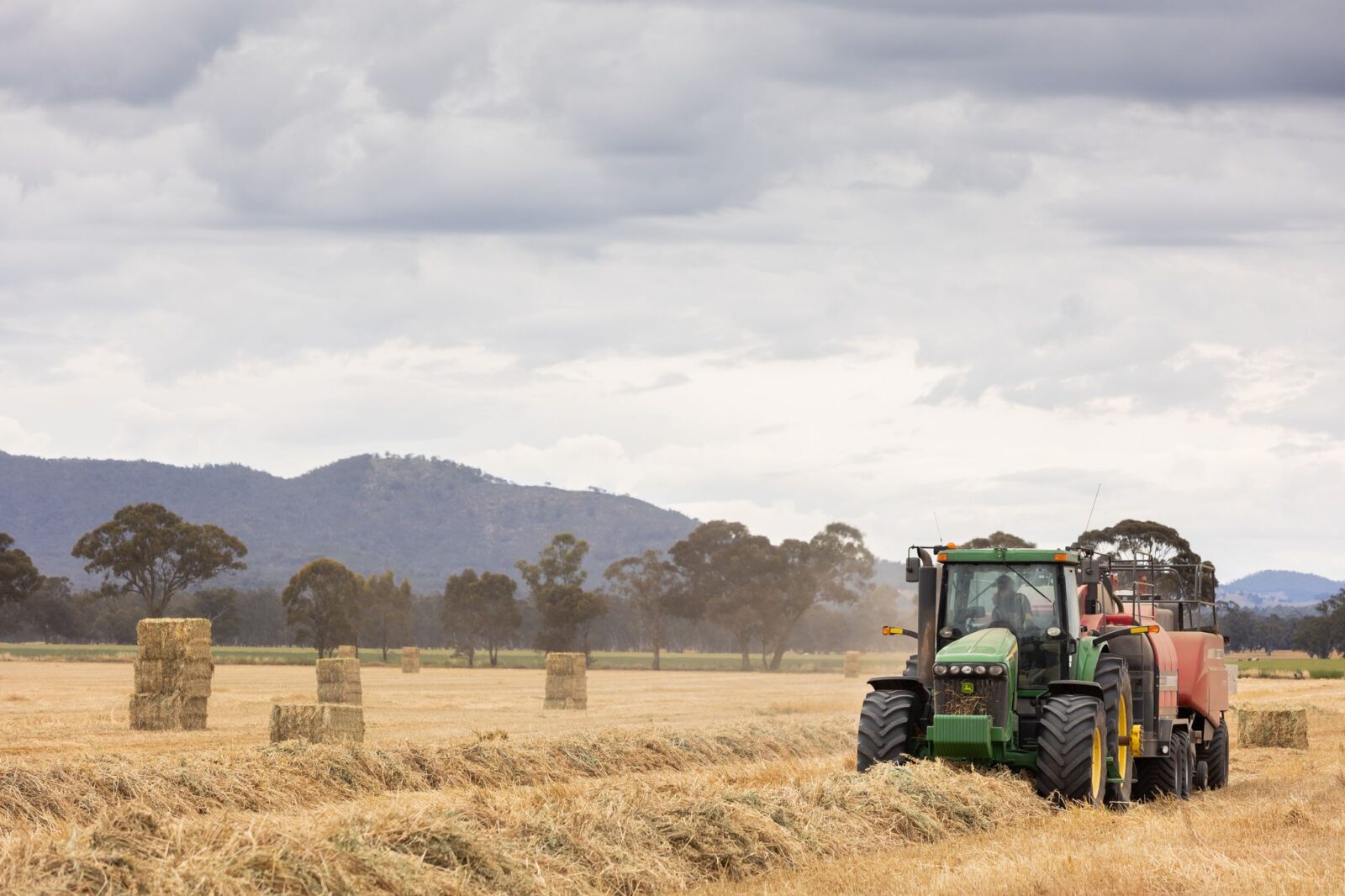How Isabelle Duff aims to drive genetic innovation in agriculture
 EXPORT FODDER / Friday, 22 November 2024
EXPORT FODDER / Friday, 22 November 2024
Export fodder projects underpin a growing global market

Australia’s export fodder industry is worth approximately half a billion dollars a year thanks to a booming export market, injecting a strong financial return into growers’ businesses. Behind the success of these markets are research, development and extension projects that safeguard this sector and support its future sustainability and expansion.
The AgriFutures Export Fodder Program invests levies ($0.50 per tonne of export fodder) in research, extension and development (RD&E) to harness leading-edge technologies that develop a competitive advantage in the export markets. The Program focuses on increasing export hay production with four key objectives:
- Production of high-quality export-grade fodder
- Continued access to export markets
- Supporting innovation across the supply chain
- Increased adoption of RD&E outputs by industry.
According to AgriFutures Export Fodder Program Manager, James Holding there are 14 priority projects that are currently funded through the Program.
“The core project for the Program is the National Oat Breeding Program which is managed by InterGrain in WA. It ensures our RD&E program continues to identify new varieties that can better service our industry’s requirements.”
The Export Fodder Program has also prioritised funding towards safeguarding market access into other countries. This key project aims to evaluate different control measures for weather-induced fungal staining and also to make growers aware of overseas chemical residue regulations.
Weather damage control measures that focus on economics
Kylie Chambers from the Department of Primary Industries and Regional Development (DPIRD, WA) is the lead manager of the project Understanding and reducing weather-induced fungal staining of oaten hay windrows.
Based in WA, the project, which is expected to run for three years, aims to improve fodder quality through reducing weather-induced damage caused by saprophytic fungi.
Saprophytic fungi are micro-organisms that feed on dead and decaying organic matter. They reduce hay quality and therefore, its suitability for export markets. Minimising the impact of this fungi is key to maximising economic returns for both the grower and the exporting company.
“Hay that has been cut and swept into windrows and is curing is the perfect environment for saprophyte colonisation,” Kylie said.
“It may have been top-tier nutritional quality hay, but weather damage will knock back its value and can cost the grower about $150 a tonne.
“That’s why it is important to find economical management strategies for growers to reduce the impact of weather damage.”
Kylie explained that the project had three objectives.
1. Identifying the causative agent(s)
To identify the different species involved in the staining process, saprophyte-affected hay samples are sourced from paddocks across oat-growing regions of WA. Kylie then completes DNA extractions and sequencing to ascertain what saprophyte species are present.
“Once we understand the saprophyte species present, we can use this to work out the best form of management options for growers,” Kylie said
2. Investigating environmental and biological drivers
The project investigates what environmental conditions induce saprophyte damage, such as rainfall or cool or warm temperatures.
Spore traps are used to capture airborne spores across the hay growing and curing season and are co-located with weather stations to capture environmental data. Kylie’s team then identify and count the spores present and overlay the environmental data onto a graph to ascertain what environmental conditions might be driving these different species.
“Our results will tell us which environmental conditions increase the presence of different saprophyte species,” Kylie explained.
3. Management options
The project also includes testing different fungicide modes of action, application timings and fungicide alternatives to mitigate weather damage.
Kylie explained that it was important to determine the safest time to apply the late-season fungicide application to reduce the chance of chemical residues exceeding the maximum residue limits (MRLs) for the different export markets.
“This is important as in WA it has become common practice for growers to apply late-season strobilurins (a fungicide group) as an insurance spray against weather damage,” she said.
“So, we are looking at different fungicides to see how early we can apply them in season to avert saprophyte damage but at the same time increase cutting window flexibility and reduce the MRL risk.
“Maintaining market access is pivotal to our export fodder industry so the project will provide growers and exporters with updated information on the causes and management options for suppression of weather-induced saprophyte growth which causes discolouration to hay post-harvest.”
The project is also looking at products that can dry the windrowed hay faster so bailing can occur earlier, to reduce the risk of rain on the windrow and saprophyte damage.
As an alternative to chemical intervention, the project is working with InterGrain to investigate if there are any differences between varieties that may be more susceptible or resistant to saprophytic fungi colonisation.
“Our end goal is to give growers safe and economical production management options,” Kylie said.
Keeping the ‘export’ radar on chemical regulations
Gerard McMullen from McMullen Consulting is leading an ongoing Chemical Residue project that monitors the industry’s compliance with chemical regulations in different export sectors.
Gerard has more than 20 years’ experience in this sector and his project is pivotal to the industry maintaining export market share moving forward.
“My project monitors chemical regulation changes in both domestic and export markets so growers and exporting companies adhere to the different MRLs,” Gerard said.
There are three areas within the project that involve Gerard continually working with and advising the industry:
- Monitoring impending export market chemical requirements and any changes to regulations
- Ensuring export companies and growers are abreast of applicable chemical regulations for all the different export fodder markets
- Managing the input of all data and maintaining the online chemical recording system (Fodder Safe) for the Australian export hay industry.
Gerard explained that the simple online tool was user-friendly and allows hay growers and exporters to ensure their fodder is suitable for their export markets.
“I manage the system for Agsmart on behalf of participating exporters who own and fund the program through AgriFutures Australia,” he said.
Gerard’s role is to gather all the relevant data from growers and highlight the chemical usage for the year.
“It is a massive job in terms of keeping on top of all the different chemical regulations for each export market,” he said.
“However, a lack of compliance from the Australian export fodder industry has the potential to cause detrimental harm to future valuable markets.”
For Gerard to understand the changing market regulations he has an enormous database of more than 100 countries and between 800 to 900 chemicals to monitor.
The project also reviews the current and impending changes to market requirements for mycotoxins and heavy metals and their impact on various export market regulations.
“I watch this space closely as there is now a larger risk profile on mycotoxins and heavy metals in terms of their impact on animals,” Gerard said.
“Certain export markets have chosen to focus on these two areas, so to assist the industry in understanding the risks relating to these two areas I provide data for each fodder commodity on request.
“We are lucky that within the Australian export fodder industry there is a very strong relationship between exporting companies and growers and any changes to regulations are quickly funnelled down the supply chain.
Gerard stressed that it was all about traceability, and the industry’s supply chain had that under control. “At the end of the day, we need to be able to highlight our clear transparency when supplying all the valuable export fodder markets.”
Fast facts in the export fodder market
Australia has about 38,000 properties producing commercial fodder crops with an estimated 1500 – 2000 growers exporting fodder. WA produces 40%, followed by VIC and SA producing 31% and 21%.
The main export markets are Japan, China, Korea and Taiwan with an emerging market in the United Arab Emirates. In 2021 China did not renew many Australian export licences and as a result, an estimated 50% of the market is now in Japan.
The export market is focused on both hay yield and quality including nutritional and physical quality (for example, stem thickness, good colour and minimal staining discolouration).
Find out more about the AgriFutures Export Fodder Program
Subscribe to AgriFutures Export Fodder Program news and updates
Latest News
-
How Isabelle Duff aims to drive genetic innovation in agriculture WORKFORCE AND LEADERSHIP / 22.11.24
WORKFORCE AND LEADERSHIP / 22.11.24 -
AgriFutures Australia welcomes new Chairman CORPORATE / 22.11.24
CORPORATE / 22.11.24 -
Protecting Australia's beekeeping future through smart traceability HONEY BEE & POLLINATION / 22.11.24
HONEY BEE & POLLINATION / 22.11.24 -
Meet your future agronomists: The five Horizon Scholars getting a career head start WORKFORCE AND LEADERSHIP / 22.11.24
WORKFORCE AND LEADERSHIP / 22.11.24






